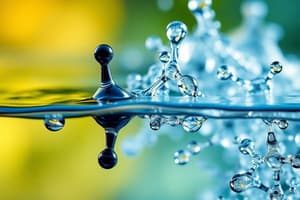Podcast
Questions and Answers
What process do protostomes use to form their body cavity?
What process do protostomes use to form their body cavity?
- Entrocoely
- Schizocoely (correct)
- Acoelomate formation
- Mesodermal splitting
Which of the following statements correctly describes deuterostomes?
Which of the following statements correctly describes deuterostomes?
- The anus forms before the mouth during development. (correct)
- Their blastopore develops into the mouth.
- They undergo spiral cleavage.
- They are primarily composed of invertebrates.
What is a key characteristic of bilateral symmetry in animals?
What is a key characteristic of bilateral symmetry in animals?
- It is less complex than radial symmetry.
- It is limited to aquatic organisms.
- It allows for stationary lifestyles.
- It supports a higher level of body part specialization. (correct)
Which group is NOT an example of a protostome?
Which group is NOT an example of a protostome?
During early embryonic development, how does cleavage differ between protostomes and deuterostomes?
During early embryonic development, how does cleavage differ between protostomes and deuterostomes?
Which feature enhances environmental awareness and response in bilaterally symmetrical animals?
Which feature enhances environmental awareness and response in bilaterally symmetrical animals?
Which of the following statements about coelom formation is correct?
Which of the following statements about coelom formation is correct?
What does the term 'determinacy' refer to in the context of protostomes?
What does the term 'determinacy' refer to in the context of protostomes?
What allows carbon to create a wide variety of organic molecules?
What allows carbon to create a wide variety of organic molecules?
Which of the following is NOT a major biomolecule formed from carbon?
Which of the following is NOT a major biomolecule formed from carbon?
What type of compound is formed when carbon bonds with hydrogen?
What type of compound is formed when carbon bonds with hydrogen?
What is the primary function of carbohydrates in living organisms?
What is the primary function of carbohydrates in living organisms?
Which of the following statements about isomers is true?
Which of the following statements about isomers is true?
During cellular respiration, what do organisms primarily break down for energy?
During cellular respiration, what do organisms primarily break down for energy?
What role do lipids play in living organisms?
What role do lipids play in living organisms?
Which component of DNA is primarily responsible for its structure?
Which component of DNA is primarily responsible for its structure?
What role does water play in the process of photosynthesis?
What role does water play in the process of photosynthesis?
How does water contribute to temperature regulation in organisms?
How does water contribute to temperature regulation in organisms?
What is the significance of water providing turgor pressure in plants?
What is the significance of water providing turgor pressure in plants?
Which property of carbon allows it to form complex organic molecules?
Which property of carbon allows it to form complex organic molecules?
In what way does water function in the excretion and waste removal systems of organisms?
In what way does water function in the excretion and waste removal systems of organisms?
What is the role of water in the structural support of aquatic ecosystems?
What is the role of water in the structural support of aquatic ecosystems?
What is catenation and why is it important for carbon?
What is catenation and why is it important for carbon?
What is one way in which blood serves a similar purpose to sap in plants?
What is one way in which blood serves a similar purpose to sap in plants?
What type of body cavity do coelomates possess?
What type of body cavity do coelomates possess?
Which group is classified as a pseudocoelomate?
Which group is classified as a pseudocoelomate?
What is one major significance of body cavities in animals?
What is one major significance of body cavities in animals?
Which of the following best describes an acoelomate organism?
Which of the following best describes an acoelomate organism?
How is the coelom formed in enterocoelomates?
How is the coelom formed in enterocoelomates?
What advantage does having a true coelom provide within an organism's body plan?
What advantage does having a true coelom provide within an organism's body plan?
Which of the following types of organisms typically contains a hydrostatic skeleton?
Which of the following types of organisms typically contains a hydrostatic skeleton?
What defines a homologous structure?
What defines a homologous structure?
Which of the following describes the cleavage pattern of protostomes?
Which of the following describes the cleavage pattern of protostomes?
What is the main characteristic of acoelomates?
What is the main characteristic of acoelomates?
Which of the following is an example of a deuterostome?
Which of the following is an example of a deuterostome?
What distinguishes coelomates from both acoelomates and pseudocoelomates?
What distinguishes coelomates from both acoelomates and pseudocoelomates?
Which animal type relies primarily on diffusion due to limited organ development?
Which animal type relies primarily on diffusion due to limited organ development?
How do pseudocoelomates benefit from their body structure?
How do pseudocoelomates benefit from their body structure?
Which of the following correctly describes coelomate organisms?
Which of the following correctly describes coelomate organisms?
Which statement is false regarding protostomes and deuterostomes?
Which statement is false regarding protostomes and deuterostomes?
Flashcards are hidden until you start studying
Study Notes
Water and Its Roles in Living Organisms
- Water acts as a solvent, transporting essential molecules like oxygen, nutrients, and waste products.
- It helps regulate body temperature due to its high heat capacity.
- Water provides habitats for aquatic organisms, and its buoyancy supports a wide range of aquatic life.
- Water contributes to plant structure by providing turgor pressure, keeping cells rigid.
- It plays a role in excretion and waste removal by dissolving waste products and allowing their removal through various bodily fluids.
- Water is a key ingredient in photosynthesis, the process by which plants convert sunlight into chemical energy.
Carbon and Its Significance in Life
- Carbon is the fundamental building block of life, forming the basis of all organic compounds.
- Its tetravalency allows it to form four covalent bonds, enabling the creation of complex and diverse molecules.
- Carbon’s ability to bond with itself (catenation) allows for the formation of long chains, branched structures, and rings.
- Carbon forms stable single, double, and triple bonds with other elements, leading to a wide variety of organic molecules.
- Due to its small atomic size, carbon forms strong and stable covalent bonds, making the resulting compounds suitable for biological processes.
- Carbon bonding with hydrogen creates hydrocarbons, important energy-rich compounds for energy storage.
- Carbon-containing molecules can exist as isomers, with different arrangements of atoms, contributing to diversity of functions.
Carbon as the Building Block of Biomolecules
- Carbon is the backbone of the four major biomolecules essential to life:
- Carbohydrates: These provide energy and structural support.
- Lipids: They contribute to energy storage, cell membrane structure, and signaling.
- Proteins: Composed of amino acids, proteins perform various functions including catalysis, structural support, and cell communication.
- Nucleic Acids: DNA and RNA, responsible for genetic information storage and transmission, are composed of carbon-based nucleotides.
Carbon in Energy Storage and Transfer
- Carbon-based molecules, especially carbohydrates and lipids, are crucial for energy storage.
- Cellular respiration involves breaking down these molecules to release ATP, the energy currency of cells.
Types of Body Symmetry
- Bilateral symmetry: Humans and many other animals possess bilateral symmetry, meaning their body can be divided into two symmetrical halves, with a head and a tail end.
- Significance of Bilateral Symmetry:
- Associated with active, mobile animals that need to move forward.
- Cephalization (head region development) allows for concentration of sensory organs, enhancing environmental awareness and response.
- Supports specialization of body parts and development of complex organ systems.
Embryonic Development and Body Cavity Formation
-
Protostomes: In these animals, the mouth forms first during development.
- Blastopore (first opening) becomes the mouth.
- Spiral cleavage is determinate, meaning the fate of each embryonic cell is determined early on.
- Coelom forms through schizocoely, where solid masses of mesoderm split to form the body cavity.
- Examples: Mollusks, annelids, and arthropods.
-
Deuterostomes: In these animals, the anus forms first during development.
- Blastopore becomes the anus, and the mouth forms later.
- Radial cleavage is indeterminate, meaning cell fate remains flexible for a longer period.
- Coelom forms through enterocoely, where mesoderm buds off from the archenteron to form the cavity.
- Examples: Echinoderms and chordates.
Types of Body Cavities
-
Acoelomates: Animals lacking a true body cavity.
- Have solid mesodermal tissue filling the space between the digestive tract and the outer body wall.
- Simple body structure with three germ layers, limited development of organ systems.
- Examples: Flatworms.
-
Pseudocoelomates: Animals with a false body cavity (pseudocoelom).
- Fluid-filled space exists between endoderm and mesoderm, not fully lined by mesoderm.
- Act as hydrostatic skeletons for movement, but organ system complexity is limited compared to coelomates.
- Examples: Roundworms (nematodes).
-
Coelomates: Animals with a true body cavity (coelom).
- Coelom is fully lined with mesodermal tissue, allowing for independent organ development.
- This cavity enables complexity in organ systems and structures.
- Examples: Vertebrates, annelids, and mollusks.
Importance of Body Cavities
- Hydrostatic skeleton: In pseudocoelomates and coelomates, the cavity acts as a hydrostatic skeleton, aiding in movement and support.
- Organ development: Coelomates have a body cavity that allows for the development of complex organ systems.
- Space for organs: The body cavity allows internal organs to grow and function independently, leading to greater complexity.
Homology
- Homologous structures: Traits shared between species that were inherited from a common ancestor.
Studying That Suits You
Use AI to generate personalized quizzes and flashcards to suit your learning preferences.




